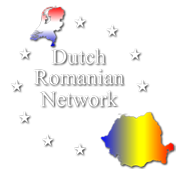Newsletter March 22, 2022

Romanian Business Day April 14 – Right now!
Barely recovered from the effects of the Covid-19 pandemic, we are faced with an unprecedented humanitarian tragedy in Ukraine. Thinking of the images in which women and children have to say goodbye to their husband and father, it leaves no one untouched.

The financial and economic consequences of this tragedy are a complicating factor. Especially now, in these uncertain times, there is a need for mutual exchange of knowledge and experience that can offer a certain handhold. Because a substantial number of the members are directly or indirectly affected by this.

In the leafy and atmospheric ambiance of the Heerlijkheid Mariënwaerd in Beesd, the Romanian Business Day offers you a strong substantive program and plenty of networking opportunities. We offer you a varied program with a number of expert speakers on current topics and under the current star
This year, too, we are organizing so-called Round Table discussions where you can talk to experts and your fellow entrepreneurs about topics that may be relevant to you in this complicated situation.
The day will be concluded with a networking drink.
Participation in this day is free for members of the Dutch Romanian Network, media and industry associations.
For non-members the costs are € 50 per person, excluding VAT.
To consult the program and to register, please click here .
We hope to welcome you!
DRN welcomes Mepro Sourcing BV from Schoonhoven
 MEPRO specializes in the development, production and supply of metal products.
MEPRO specializes in the development, production and supply of metal products.
They have offices in the Netherlands, Romania and China. The focus is on developing and producing industrial products. Both in single or single pieces and serial production. Here they work together with various specialized production companies. In 2010, they opened a warehouse in Brasov (Romania) for the supply of modern CNC-controlled machining machines (CNC turning, CNC milling, Robots). From the beginning of 2018, this has been expanded with a modern production facility for high-quality turning and milling work, for both single pieces and series production.

For further information, please refer to: www.mepro.com
Accounting & compatibility between the Netherlands and Romania
Did you know that more than 5500 Dutch companies invest in Romania? An impressive number, making the Netherlands the largest foreign investor in Romania for more than 15 years in a row. The relative proximity, highly educated population and low(er) costs are undoubtedly factors that play an essential role in choosing Romania. In the last 10 years, an aspect has been added – certainly in the Bucharest region – namely a greatly improved business infrastructure. The presence of professional tax specialists, accountants, civil-law notaries and lawyers who speak fluent English and are often affiliated with internationally operating organizations.

Dutch companies with a branch or independent establishment in Romania invariably run into the fact that the accounting systems in the Netherlands and Romania differ on essential points. If you only see the bookkeeping as a local tax obligation, that is no problem at all. When you also see accounting as a means of exercising control, things change. And when you see your company’s accounting in Romania as an instrument for reporting and guiding policy-making decisions, the incompatibility between Dutch and Romanian accounting systems becomes a real problem.
Admittedly, with the right scale of your company you simply standardize worldwide to a financially driven ERP system (Enterprise resource planning) such as SAP or Navision – problem solved – but for many non-corporate organizations the price tag that comes with it is simply disproportionate. 
DRN stimulates, promotes and represents the (trade) interests of Dutch companies that do business in Romania and can provide a series of practical tips that make it possible to edit the data of almost every Romanian accounting package in such a way that an integral import into your own Dutch accounting program becomes possible. This way you can follow up to transaction level what is happening in your Romanian branch and release the reporting functions of your Dutch package on consolidated data.
Know how to? Then we recommend that you register for the Romanian Business Day where you can receive further explanation in the informal setting of a Round Table discussion.
In addition, as a DRN member you can obtain the special Whitepaper “Romanian entities administrative processing in the Netherlands”. It may also be a consideration for non-members to become a member.
Maritime Sector
Alewijnse Completes Complete Installation on Two Pioneering Marine Aggregate Dredgers
 System integrator Alewijnse has successfully delivered the electrical installation on two innovative MAD 3500 in the Marine Aggregate Dredger class to Damen Shipyards Group. The recent handover of the second vessel marks the completion of a three-year project in Romania.
System integrator Alewijnse has successfully delivered the electrical installation on two innovative MAD 3500 in the Marine Aggregate Dredger class to Damen Shipyards Group. The recent handover of the second vessel marks the completion of a three-year project in Romania.
The two ships were built for CEMEX UK and Hanson UK respectively. They currently sail along the south coast of England, where they dredge sand and aggregates in the Channel for the UK construction industry. The two identical vessels represent a new generation of efficient, productive and sustainable dredgers for the extraction of sand and gravel from the seabed.

Alewijnse scope
The project was extensive for Alewijnse, including the engineering, delivery and commissioning of the complete electrical package, including the electrical panels, switchboards, cables, the alarm and monitoring system (AMS) and power management systems. In addition, Alewijnse was responsible for the ironwork and general installation work, and the installation of the electrical systems for driving the dredging equipment and vessel management systems.
Complex ships
Construction took place at Damen Shipyards Galati, Romania. “We are happy with the end results,” concludes Alewijnse project manager Ionut Melescanu. “The projects were challenging, not least because of all the limitations of the corona pandemic. We have also been intensively involved in the engineering, which, due to the complexity of the ships, underwent major development during the course of the project. This was an advantage during the construction of the second ship and we were able to put this knowledge and experience to good use.
The MADs 3500 are the most complex vessels we have worked on at Damen Galati to date. We are very proud of what we have achieved together. Alewijnse has once again shown that we can successfully deliver the most complex and new vessels, under very challenging conditions.”
Good cooperation
Client Damen chose Alewijnse because of the good cooperation in the construction of previous ships and its specialist skills and permanent location of Alewijnse at Damen’s shipyards in Galati and Mangalia.
Valentin Petrea, operations manager at Alewijnse: “Because it is a new design, I am pleased that we have been involved in the project from the start, so that we can jointly make this challenging concept a success. We are happy to use our knowledge and experience again to satisfy the customer. In this way we hope to provide added value, so that Damen will be commissioned even more of these types of ships in the future.”
Damen Shipyards makes port patrol vessels more sustainable
Port of Amsterdam signs for maintenance and sustainability of patrol ships. A new engine, exhaust gas cleaning systems and an improved drivetrain deliver emissions reductions for the Damen Stan Tug 1907 PA1. Port of Amsterdam and Damen Shipyards sign a contract for the conversion of the vessel. In this way, Damen contributes to the sustainable ambitions of the Port Authority.
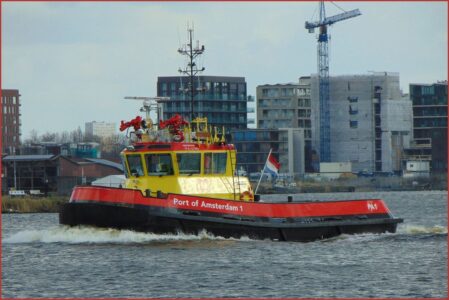 Modifications and innovations to the patrol vessel result in fewer emissions and more efficient deployment within the Port of Amsterdam. The conversion involves installing new engines that meet IMO Tier III and EUROVI stage 5 emissions standards. A particulate filter (DPF system = diesel particulate filter) and a nitrogen catalyst (SCR system = selective catalytic reduction) are installed.
Modifications and innovations to the patrol vessel result in fewer emissions and more efficient deployment within the Port of Amsterdam. The conversion involves installing new engines that meet IMO Tier III and EUROVI stage 5 emissions standards. A particulate filter (DPF system = diesel particulate filter) and a nitrogen catalyst (SCR system = selective catalytic reduction) are installed.
The patrol vessel will be equipped with a heat recovery system that will heat the accommodation and the bridge. The insulation of the wheelhouse is improved, with all glass replaced. In addition, new rudders and new propellers will be installed and the anchor lockers will be adjusted. The ship was built in 2013 by Damen Shipyards and has been active in the port of Amsterdam ever since. After conversion, the PA1 will be delivered for renewed use in mid-June this year.
Port of Amsterdam has the ambition to further reduce emissions from shipping. Making our own fleet more sustainable makes a significant contribution to this. After the conversion, the PA1 will be used for port infrastructure maintenance and supervision in the ports of the North Sea Canal. By choosing Damen Shipyards, Port of Amsterdam is continuing its long-term relationship.

In addition to the tender for the conversion & refit of the PA1, the shipbuilding group also won the maintenance contract for the 4 Damen ships in the Port of Amsterdam fleet, based on the knowledge of the ships and the action plan. Port of Amsterdam still has three ships from Damen Shipyards in active service: two Stan Tug 1907s and a Stan Tender 1905.
Agricultural sector
Romania reports second largest increase in EU poultry and pork prices
Prices increased by 15-21%Compared to last year, the prices of poultry and pork increased by 21% and 15% respectively at the farm. Of the EU countries, both pork and poultry have the second highest price increase.
Since the beginning of this year, the price of poultry meat at the farm has risen weekly to an increase of 21.5% compared to the same period last year. Specifically, according to the European Commission, in the week of February 7, the price reached 167.8 euros per 100 kilograms of carcass, 4.6% more than the previous month and 1.4% more than the previous week. Romania thus reported the second largest price increase in the European Union compared to 2021, after Italy (plus 50%) in the context where local farmers have the cheapest meat. Compared to the European average, poultry sold in Romania is 55 euros (25%) cheaper. The most expensive poultry is sold in Germany – 331 euros per 100 kg carcass. The industry has been hit hard by rising electricity and gas prices, and in over the past year, production has covered less consumption.
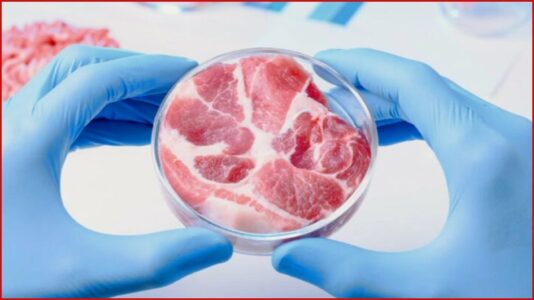 Pork has become 15% more expensive than last year
Pork has become 15% more expensive than last year
A similar situation has been reported in the case of pork, where we have the second largest price increase in the EU compared to the same period last year. The price at the gate of the farm reached 128.46 euros in the week of February 7, the carcass of 100 kilograms of class S meat, 15.1% higher than in the same period last year. However, compared to the previous week, the price fell by 7.8% and compared to the previous month by 0.8%.
The largest increase in the EU was reported in Croatia (plus 20%), while prices in the EU rose by an average of 0.4%. there are also countries where pork is cheaper – in Latvia the average price is 109 euros per 100 kilograms of carcass, in the Netherlands the average price was 112 euros and in Belgium it is 119 euros.
The European Commission will subsidize the private storage of pork
Finally, under pressure from European farmers, the European Commission decided to intervene in the pork market and provide financial support to private meat storage, where stocks are high. Due to the surplus created by the inability to export, the price of meat has fallen in some Western European countries. However, in Romania we have the highest annual growth rate in the EU, at 20%.
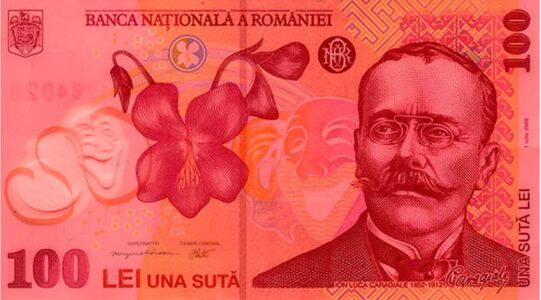 The European Commission, after lengthy debates, has agreed to intervene in the pork market, financing, where there are large stocks, private storage, said at a conference hosted by Profit Agricl, Achim Irimescu, Minister Plenipotentiary for Romania’s Representation in the EU. “In the Special Committee on Agriculture, the Commission has devised a number of measures. The most affected is the pork sector. African swine fever has led to China’s decision to stop importing pork from the EU without recognizing regionalization. So the EU woke up with stocks of 2 million tons of pork. (…) After lengthy discussions, the Commission has proposed intervention in the pigmeat market. Private storage is certainly applicable. Spain, which sells in China, has huge inventories. The same applies to Germany, Benelux and Poland.
The European Commission, after lengthy debates, has agreed to intervene in the pork market, financing, where there are large stocks, private storage, said at a conference hosted by Profit Agricl, Achim Irimescu, Minister Plenipotentiary for Romania’s Representation in the EU. “In the Special Committee on Agriculture, the Commission has devised a number of measures. The most affected is the pork sector. African swine fever has led to China’s decision to stop importing pork from the EU without recognizing regionalization. So the EU woke up with stocks of 2 million tons of pork. (…) After lengthy discussions, the Commission has proposed intervention in the pigmeat market. Private storage is certainly applicable. Spain, which sells in China, has huge inventories. The same applies to Germany, Benelux and Poland.
More than 13 million tons of grain will no longer be on the market
Early estimates after the outbreak of the armed conflict in Ukraine show that the agricultural market could be short of 13.2 million tons of wheat, maize and barley this year. The amount will only be partially offset by the supplies of other world powers.
The Russo-Ukrainian war has released about 7 million tons of wheat that should have fed the world this marketing season, according to the latest estimates from the United States Department of Agriculture (USDA). These are the quantities that Ukraine and Russia will no longer be able to export this trading year because of the mutual conflict. For example, Ukraine’s exports could be limited to 20 million tons this year and Russia’s exports to 32 million tons. Of the major exporters, they will deliver less to the US, at 500,000 tons, and Egypt, at 400,000 tons.
The shortfall will be partially offset by deliveries from Australia, which will export 1 million tons more than originally estimated. Australia has improved production, but also better prices than other major manufacturers.
There will also be more Indian wheat on the market, with the USDA estimating an additional 3 million metric tons, up to 10 million metric tons, as a result of growing inventories. The price of wheat in India is also competitive. At the same time, an increase in exports of 200,000 tons from Brazil is expected.
In total, the USDA estimates that exports will increase by 4.2 million tons.
“The conflict in the Black Sea has disrupted the grain flow in the region and has led to major energy losses and uncertainty in the world grain trade. Ukraine has suspended port activities for trade since February 24. The circulation of Russian grain through the Black Sea is also affected by exceptionally high marine insurance premiums. In addition, the sanctions imposed make doing business a challenge. In response, grain prices have skyrocketed for all major exporters,” reads the USDA’s first forecast after Russia’s invasion of Ukraine.
Wheat, maize and barley are the main grains supplied by Ukraine and Russia. In the case of wheat, Ukraine represents 10% of world exports and Russia 16% in the 2021/2022 marketing year, which started in July. Most Ukrainian wheat exports are shipped in the first few months of the marketing season, but port closures are currently limiting additional exports. As for the affairs of Russia, it has imposed export duties on all countries except the UAE, including Belarus. Ship access to the Caspian Sea has also been maintained.
Min 6 million tons of maize
The blockade in Ukraine means minus 6 million tons of maize and minus 200,000 tons of barley for the world market. According to the latest estimates, Ukraine will deliver only 27.5 million tons across the borders. Instead, the other big producers can supply more – Argentina – 500,000 tons, just like Brazil. In total, the exports of the major players will increase by 1.8 million tons compared to the previous forecast.
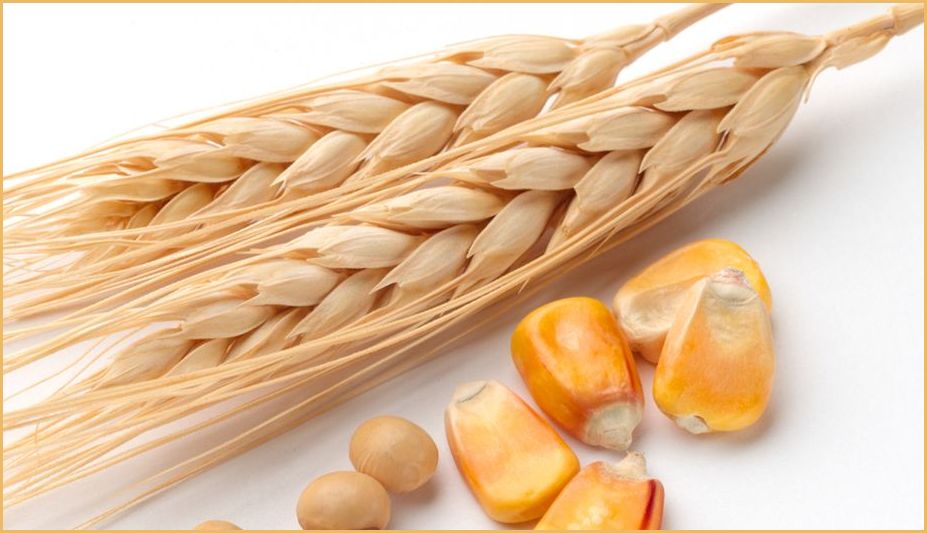
Still, Turkey (which will import 500,000 tons less), Israel (minus 300,000 tons), Egypt (import 600,000 tons less) and Algeria (minus 500,000 tons) will be hardest hit by the Black Sea conflict.
“Maize import forecasts for 2021/22 are lower this month for the Middle East and North Africa due to the closure of Ukrainian ports on the Black Sea and sanctions against Russia. Disruptions in the Black Sea have contributed to higher volatility in the prices of maize and other grains. It is too early to predict the final cost, but data from exporters shows that shipments in the first four months (October 2021 – January 2022) are higher than a year ago, implying strong demand in the region, despite high Prices. USDA analysts.
Wheat and barley exports from Romania, the largest in the EU
Romania exported 179,300 tons of wheat and 47,700 tons of barley outside the EU bloc in the first two weeks of March. It is the largest amount sold in the EU during this period. Ukraine is expected to cover 10% of world wheat and 17% of barley exports this year.
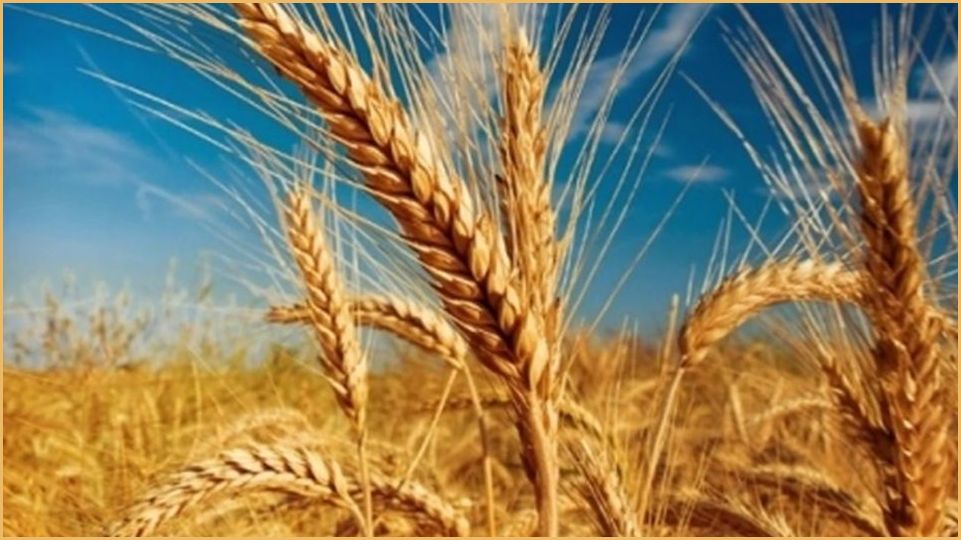
According to the latest data from the European Commission, updated on March 14, Romania has delivered the largest quantities of wheat to the EU in the past two weeks, in the context of the blockade of the Black Sea caused by the war between Russia and Ukraine.
For example, in the week of February 28, traders delivered more than 122,800 tons of wheat, followed by a further 56,500 tons the following week. In both weeks, the amount of Romanian goods is the highest in the EU. Also in comparison with the weekly export of this calendar year, we are talking about large quantities. In 2022, in at most one week, more than 200,000 tons were delivered in mid-January respectively.
France, the largest European exporter of this trading year, which started on July 1, 2021, exported 75,500 and 5,000 tons in two weeks. Significant exports in these two weeks were also reported by Germany – 96,300 tons, Lithuania – 47,400 tons or Estonia – 27,700.
In total, in the first 37 weeks of this trading year, Romania sold over 5.1 million tons of wheat across the EU borders, or 27% of the total value exported by the Member States. This makes us the second largest European exporter after France, which had a turnover of 5.7 million euros.
Major export of barley
Another grain that was sold in large quantities in the two weeks was barley, 47,700 tons respectively, of which over 38,700 tons came in the first week after the war. It is the largest quantity delivered by Romania in one week, in this calendar year.
In total, Romania sold 1.6 million tonnes of barley across the EU borders this trading year. We are the second largest European exporter after France with a delivery of more than 2.5 million tons.
In maize, we are the market leader with more than 3 million tons exported, 136,000 tons of which in the past two weeks.
According to the latest data from the US Agriculture Commission (USDA), Ukraine should have accounted for 10% of world exports this trading year, while Russia, which banned exports, accounted for a further 16%.
In the case of barley, Ukraine is the world’s second largest exporter after Australia, holding 17% of the market, while Russia has a 13% share.
Romanian fruit and vegetable industry at record level, but looming increasing import dependency
The turnover of the Romanian fruit and vegetable sector increased by 17.4% and reached a record high of 24.4 billion lei in 2020. By sub-segment, trade made the most progress, at 19% (turnover of 20.8 billion lei), processing activity increased by 12% (turnover 1.4 billion lei) and turnover of fruit and vegetable growers increased by 5% in compared to 2019 to 2.1 billion lei in 2020.
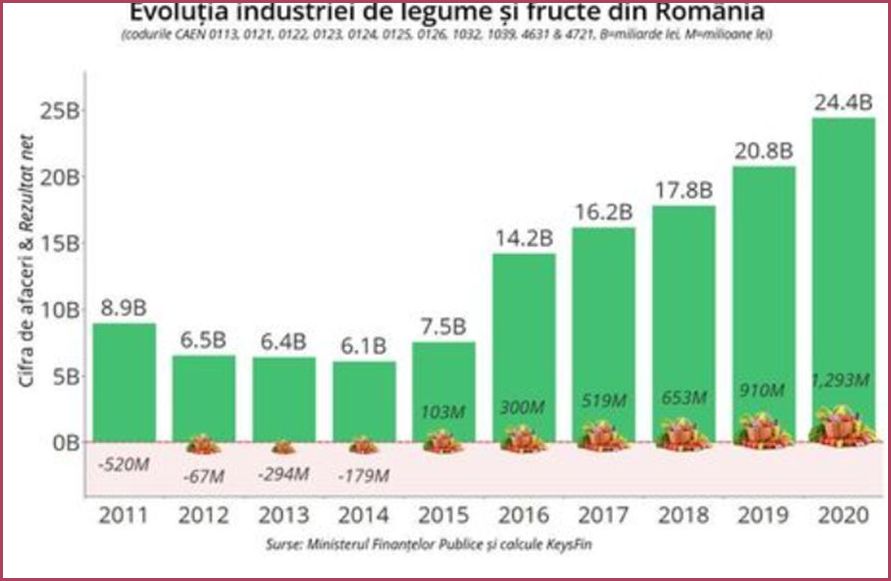
“The pandemic has led to a clear change in consumer behavior towards commodities, including fruit and vegetables. For 2021 we estimate the continuation of the growth trend started in 2014 and reaching a record level of 28 billion lei based on the increase of consumption, but also from inflationary pressures of about 10% last year,” said Diana Florescu, KeysFin economic analyst. The net result of the fruit and vegetable sector exceeded one billion lei for the first time, after an advance of 42% compared to 2019 and 332% compared to 2016, reaching 1.3 billion lei in 2020. By segment, the net result of the fruit and vegetable processors increased by 33%, that of the traders by 42% and on the crop side, the progress in 2020 was 50% compared to the year before the pandemic.
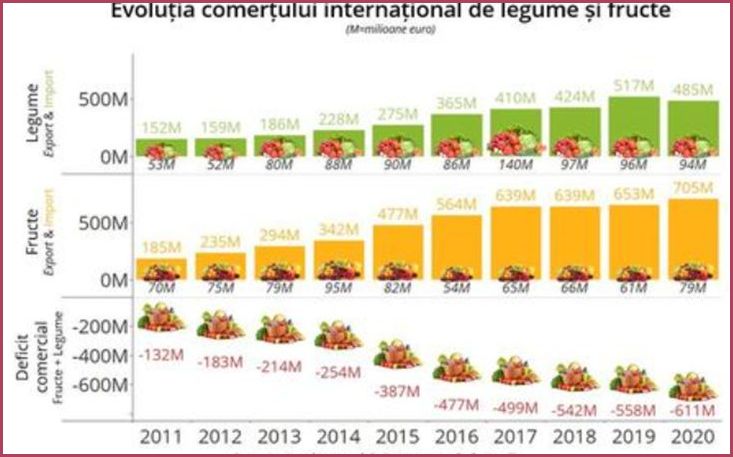
Import of fruit and vegetables historical heights
According to data from the National Statistical Institute, fruit and vegetable imports reached a record high of EUR 1.2 billion in 2020, after an annual increase of 1.6% and an increase of 252% compared to 2011. The export of fruit and vegetables increased by 9.3% compared to 2019, but only 40% compared to 2011, reaching a value of 173 million euros in 2020. The trade deficit of fruit and vegetables (Export minus Import) increased by 0.3% compared to 2019 and was 374% above the 2011 level, at the highest level in history, reaching more than one billion euros in 2020.
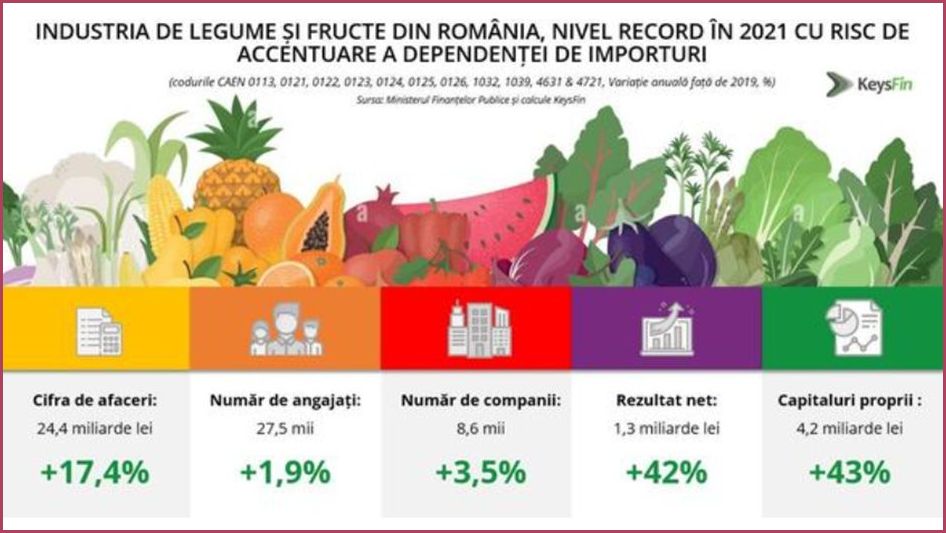
Dependence on food imports
In the medium term, analysts expect an increasing dependence on food imports in general, and implicitly also on fruit and vegetables in the context of rising commodity prices, utilities, but above all in the absence of a well-targeted national support program (agricultural infrastructure, access to financing for development and technologization of production capacity – Agriculture that does not benefit from direct allocation through the National Recovery and Resilience Plan), which can help the managers of the local fruit and vegetable sector to cope with external competition, the dependence on the local economy of imported products and to guarantee healthy and quality products for the Romanian consumer.
Aviation Sector
WizzAir supports Ukrainian refugees offering 100,000 free tickets on all flights to continental Europe
Wizz Air announces it will help Ukrainian refugees by offering 100,000 tickets for all flights to continental Europe, departing from the countries surrounding Ukraine (Poland, Slovakia, Hungary, Romania), according to a press release sent to AGERPRES on Wednesday. Overview from Wizz Air that many refugees have started migrating and may be in other locations.
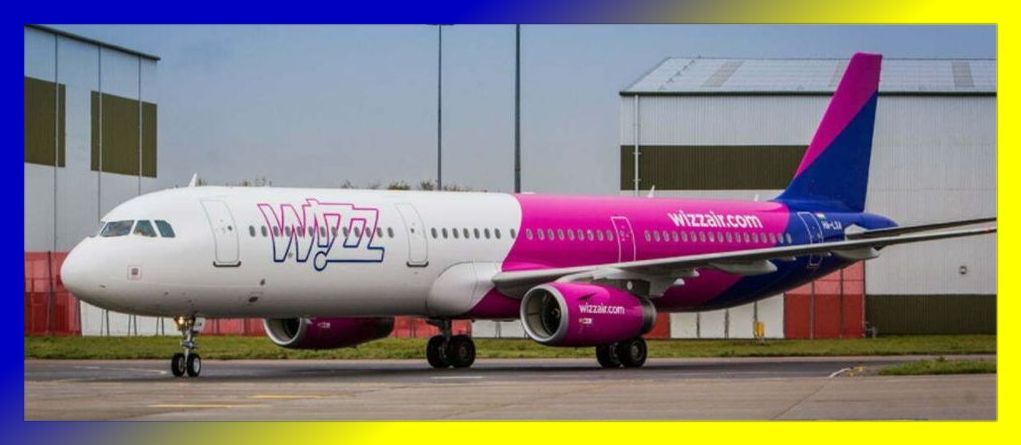
The airline also offers an auxiliary fare of 29.99 euros for all other flights (except to the UAE, Iceland and the Canary Islands, where the special fare is 69.99 euros). The 100,000 free seats and the support rate will be available throughout March. Passengers must provide the Ukrainian passport/ID number at the time of booking and the Ukrainian passport. The indicated number of tickets (100,000) at the price of zero euros will be applied up to the wagering limits for selected flights departing in March 2022. A handbag is included (maximum 40x30x20 cm). An additional fee will be charged for a trolley bag and each checked piece of luggage.
The price only applies to bookings made at https://wizzair.com/#/rescue.
Serbia has become the gateway to Europe for Russian tourists.” Almost all flights are fully booked”
Russian tourists, hit by the closure of airspace after the invasion of Ukraine, are using Serbia as a detour to visit resorts and cities in Western Europe. Serbian airlines have doubled their capacity to fly to Russia.
The number of planes connecting Russia and Serbia increased by about 50% in the first week of March, compared to the situation before the invasion of Ukraine. Also, travel from Serbia to countries like France, Switzerland, Italy and Cyprus has increased by nearly two-thirds, according to ticketing company ForwardKeys, according to Bloomberg and Agerpres.

Belgrade’s neutral stance on the conflict between Russia and Ukraine allows Air Serbia to continue flying to Russia at a time when EU and Russian airlines are not allowed to fly between the two regions. For example, Air Serbia’s operations provide a gateway to Europe for Russians who would otherwise have to bypass Turkey or the Persian Gulf.
Air Serbia declined to comment, but according to a sales agent at Belgrade airport, the Serbian airline has expanded its capacity to Moscow and St. Petersburg and even introduced a large Airbus aircraft for flights to New York.
“We just noticed then. I don’t feel good taking advantage of other people’s problems, but it’s unbelievable. Almost all flights are fully booked, and the price of the ticket is not a problem,” the sales agent revealed under the protection of anonymity.
Despite the ban on airline flights, Russians are not banned from traveling to the EU.
According to ForwardKeys, Serbia has risen from fourth to 12th place in the top of transfers for Russian travelers and has become the main hub for access to other European countries. Primarily Turkey in general, which has connections to Georgia, Germany, Great Britain and the US, followed by the United Arab Emirates and Qatar, which is mainly used for US and Asia-Pacific destinations.
Air Serbia flights by FlightRadar24 show that planes from Belgrade are leaving Moscow and traveling west across the Baltic countries to avoid Ukraine, then head south past Poland, Slovakia and Hungary, which have severed ties with Belgrade. From a historical point of view, countries such as Serbia, Bulgaria and the Russian Federation have (informal) ties with each other.
Newsletter Editor: At the time of going to press, state-owned Air Serbia announced that it has canceled all flights from Moscow to Belgrade and from Belgrade to Moscow, Russian and Ukrainian media reported. Pressured by Western sanctions against Russia and the European community, Serbian President Aleksandar Vucic later backtracked, announcing that Air Serbia would cut its flights to Russia in half, and today the company officially announced that it would be completely shutting down flights to and from Russia. would suspend.
Energy Sector
Romanian excise tax on petrol, the second lowest in the EU
Romania has the second lowest excise duty on petrol, according to the European Commission. Our 44% of the final price at the pump exceeds only that in Poland at 37%. These calculations were valid before today’s announcement (22.2.2022) by the Minister of Finance, Adrian Câciu, to halve excise duties on fuels. It should be noted that in many EU Member States a slight downward trend can be observed due to the reduction of excise duties . However, the mutual relationships will not differ much as a result of those listed in the list below.
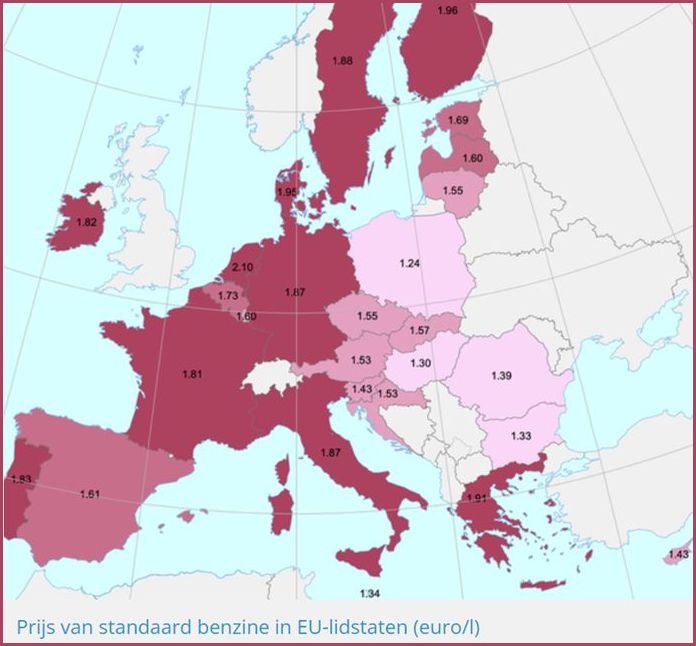
Romania has a 44% excise tax on petrol and the pump price per liter is 1.36 euros, or about 7 lei, according to the European Commission. It is the second lowest excise duty in the European Union, as only Poland with an excise duty of 37% is below Romania in this regard. If we look at their neighbors, with Bulgaria they are almost equal to the excise tax on petrol, which has 45%, but a price lower than 1.26 euros per liter. Hungary has an excise duty of 47% on petrol and a price of 1.34 euros per litre. In an EU top petrol price, our country ranks 17th out of a total of 20 countries analysed.
reduction.
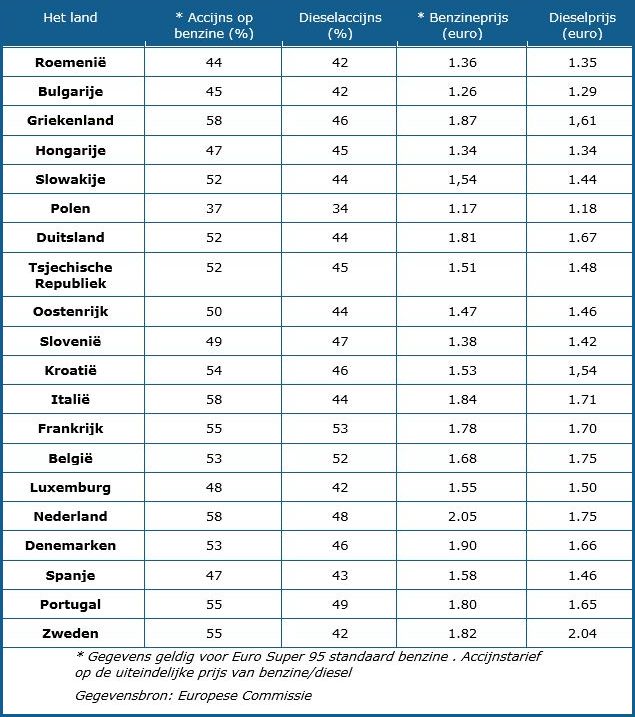
The situation is about the same for diesel. Romania’s excise duty is 42%, as is Bulgaria’s. Only the price at the pump differs. In our country, the liter costs 1.35 euros, more expensive than in Bulgaria, where it is only 1.29 euros.
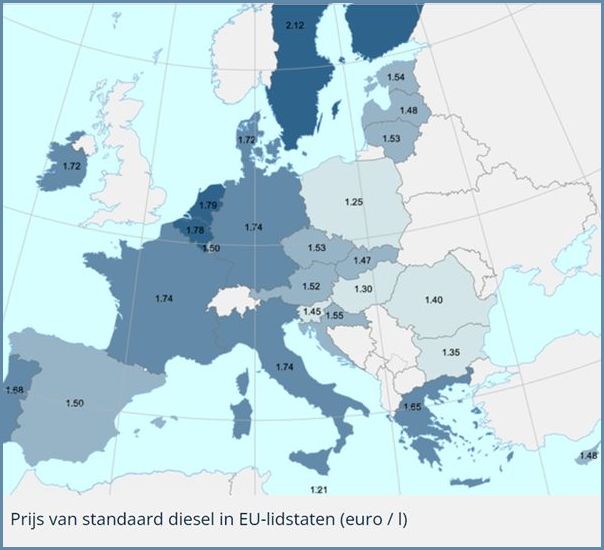
And in this case, Romania occupies the penultimate place in the top in terms of excise duties, along with Bulgaria, Luxembourg and Sweden, and last but not least, Poland, with an excise duty on diesel of 34%. The Romanian 50% reduction has not yet been included in these calculations
Geopolitical developments
Russian Patriarch Kirill spokesperson for Putin
The blunt blessing given by Patriarch Kirill of Moscow for the Russian invasion of Ukraine has shattered the world’s Orthodox Church and led to an internal uprising that experts say is unprecedented.
Kirill, 75, a close ally of Russian President Vladimir Putin, sees the war as a defensive rampart for the West, which he says is decadent, especially when it comes to accepting homosexuality.
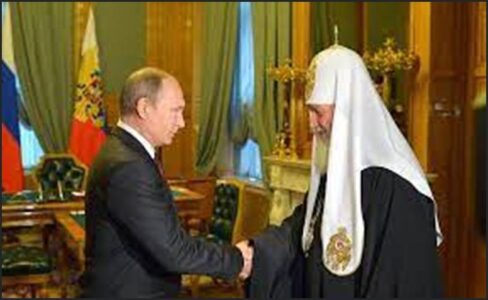 What Putin sees as a restoration, Kirill sees as a crusade. But the patriarch has caused discontent both at home in Russia and among some foreign churches affiliated with the Moscow Patriarchate. In Russia, nearly 300 members of a group called Russian Priests for Peace have signed a letter condemning “criminal orders” in Ukraine. “People in Ukraine should have their own choice, not one with a gun to the head, without pressure from the West or the East,” the priests said in the letter.
What Putin sees as a restoration, Kirill sees as a crusade. But the patriarch has caused discontent both at home in Russia and among some foreign churches affiliated with the Moscow Patriarchate. In Russia, nearly 300 members of a group called Russian Priests for Peace have signed a letter condemning “criminal orders” in Ukraine. “People in Ukraine should have their own choice, not one with a gun to the head, without pressure from the West or the East,” the priests said in the letter.
Of the 260 million Orthodox Christians in the world, about 100 million live in Russia, and some abroad are allied with Moscow.
In Amsterdam, the war convinced the priests of St Nicholas’ Parish not to mention his name during prayers. A Russian bishop visiting Western Europe tried to change their minds, but the parish announced on Monday that it had cut ties with the Moscow Patriarchate.
The Russian Orthodox Church considers Ukraine to be of crucial importance, considering it the cradle of Russian civilization, with Byzantine Orthodox missionaries converting the pagan prince Vladimir I here in the 10th century.
After the Bolshevik Revolution of 1917, communist leaders began to disintegrate the Russian Orthodox Church. But Stalin brought it back to the forefront to motivate the populace after Nazi Germany invaded the Soviet Union during World War II.
“The same idea is now being revived by Putin,” said Olenka Pevni, a professor of Slavic and Ukrainian studies at Cambridge University in London.
“As Russia’s position in the world and its Russian identity began to weaken, Putin again turned to the Church to bring the Russians under his control and try to connect people to independent countries such as Ukraine. Russia through the idea of a united Russian Orthodox Church,” she said.
Dutch Red Berets of 11th Airmobile Brigade train in Romania
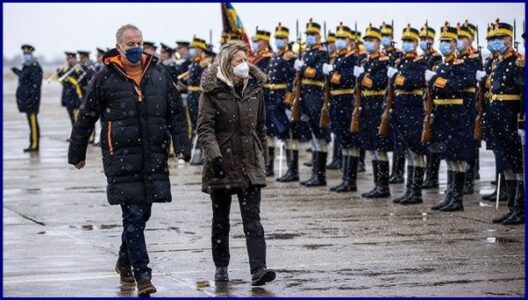 Defense Minister Kajsa Ollongren and Commander of the Armed Forces General Onno Eichelsheim were in Romania on Monday. 150 soldiers of the 11th Airmobile Brigade, also known as Red Berets, are currently training in the country.
Defense Minister Kajsa Ollongren and Commander of the Armed Forces General Onno Eichelsheim were in Romania on Monday. 150 soldiers of the 11th Airmobile Brigade, also known as Red Berets, are currently training in the country.
Romania is Ukraine’s neighbor
After arriving at Mihail Kogălniceanu Airbase, the minister first talked to her Romanian colleague. ‘As a neighbor of Ukraine and with Romania’s location on the Black Sea, the war for Romanians is very close. We talked about how we can protect our eastern flank in NATO,” said Ollongren.
To defend
Actually, the training, in which the Red Berets do helicopter operations and target practice, would take place in Germany. At the request of NATO, this is now happening on Romanian territory. Ollongren: ‘My Romanian colleague indicated that he is very happy with our presence: it reassures the inhabitants of his country. We have seen in recent days what President Putin is capable of.”
Ukraine invasion poses direct threat to borders of NATO territory
The invasion of Ukraine poses a direct threat to the borders of NATO territory.
By exercising militarily internationally, we show that we are collectively ready to defend every inch of our NATO territory. Together we are strong. In addition, an exercise like this, in which we act together with Romanian and American military personnel, contributes to interoperability between all countries,” said Ollongren.
The Dutch detachment will be deployed in Romania to participate in the Rapid Falcon 22 multinational exercise at the Babadag Secondary Center for Combat Training in Tulcea County from 7 to 24 March. The exercise will also be attended by military personnel with Captain Stefan Soverth 495th Paratrooper Battalion in Bucharest and the Marasesti 9th Mechanized Brigade in Constanta, as well as Romanian and American helicopters.
According to the Ministry of National Defense (MApN), the objectives of this joint training are to increase interoperability and joint response capability, as well as to develop functional relationships between participating structures.
Photos: Ministry of Defence
Bulgaria will house up to eight fighter jets and 200 Dutch marines
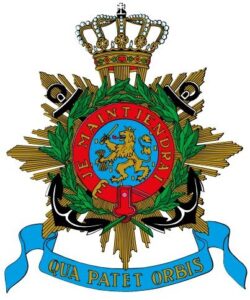 Bulgaria will host up to eight fighter jets and 200 Dutch marines to support airspace surveillance in the context of Russia’s invasion of Ukraine, according to a decision by the Sofia government on Friday, Reuters reported..
Bulgaria will host up to eight fighter jets and 200 Dutch marines to support airspace surveillance in the context of Russia’s invasion of Ukraine, according to a decision by the Sofia government on Friday, Reuters reported..
The deployment of the F-35s is the first operational deployment for the successor to the F-16. Our country is sending two F-35s and a spare aircraft to Bulgaria to contribute to the joint air defense there. About 90 soldiers are deployed for the operation. The Marine Corps is responsible for security, the so-called force protection . The aircraft come from 322 Squadron of Leeuwarden Air Base and will be stationed in Bulgaria in April and May. The F-35 has been operational since December last year.
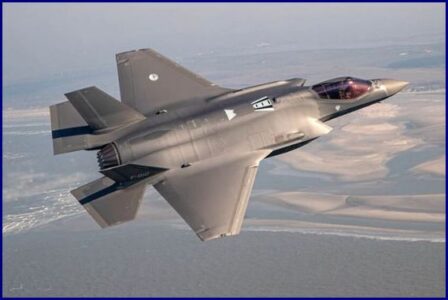 The Netherlands will deploy two 24-hour fighter jets for 24-hour air surveillance activities in Bulgaria from April 1 to May 31, in accordance with NATO’s integrated air and missile defense plan, the Bulgarian executive said.
The Netherlands will deploy two 24-hour fighter jets for 24-hour air surveillance activities in Bulgaria from April 1 to May 31, in accordance with NATO’s integrated air and missile defense plan, the Bulgarian executive said.
“To carry out these actions, a maximum of eight aircraft and a maximum of 200 Dutch Royal Air Force soldiers will be deployed in Bulgaria between March 4 and June 24,” the government decision said. Four Spanish fighter jets, supported by 130 Spanish troops, are currently supporting the surveillance of Bulgarian airspace. The government has decided to extend their mission until April 15. Bulgaria, a country on NATO’s eastern flank, is also setting up a battlegroup of up to 1,000 troops, working closely with the Alliance. The decisions came at the time that the Russian invasion of Ukraine is entering its third week.
Sector Culture
Ukrainian musicians keep courage and still hope to tour in the Netherlands
 The International Symphony Orchestra from Lviv and the National Choir of Ukraine Dumka from Kiev cannot come to our country this summer for performances of the famous music piece Carmina Burana by Carl Orff conducted by the Dutch conductor Raymond Janssen. But the 160 Ukrainians, with whom he toured our country before and drew full houses, are keeping up their spirits in the midst of the war in their country, says Janssen.
The International Symphony Orchestra from Lviv and the National Choir of Ukraine Dumka from Kiev cannot come to our country this summer for performances of the famous music piece Carmina Burana by Carl Orff conducted by the Dutch conductor Raymond Janssen. But the 160 Ukrainians, with whom he toured our country before and drew full houses, are keeping up their spirits in the midst of the war in their country, says Janssen.
They still hope for a tour through the Netherlands, which is now scheduled for the autumn. Even if they are in an air raid shelter or they help fleeing compatriots and wounded soldiers, according to the conductor. He repeatedly calls orchestra and choir members. According to him, they initially hoped that the trip could continue as planned in the summer, but the organizers do not dare to continue those plans. “It is a huge investment in terms of marketing,” explains Janssen.
“Chorus and orchestra members were initially all in severe shock after the raid. It is of course also very frightening, especially in Kiev with all those impacts and sirens, a bizarre situation. The choir members have fled or have to get to safety every time. also take care of each other, if one can offer the other a safer place.” In the somewhat quieter Lviv in the west, where many Ukrainians have fled, it is not getting any safer now, but according to Janssen the musicians are “intensively” busy with the reception of compatriots and the care with shelter, food and medicine. . “It’s really fantastic what they’re doing.” And even though people in Lviv are now also quite afraid, just like the choir members in Kiev, the orchestra members in Lviv are nevertheless positive, according to Janssen.
Conductor Raymond Janssen, who works under the name of Cadenza European Art Productions, has been known for decades that he often draws full houses in the Netherlands under complicated circumstances with Ukrainian and Romanian musicians. In 2013 he received the Romanian Business Award from the DRN for his cultural entrepreneurship
Construction sector
Construction crisis in Romania- Import 70% of building materials
Rising prices for building materials and raw materials have exposed a major problem in the construction industry. In addition to the lack of labor, Romania imports 70% of construction materials, warns Adriana Iftime, vice president of the Federation of Employers of Construction Companies (FPSC). And unrest abroad, such as the conflict between Ukraine and Russia, can also affect our market.
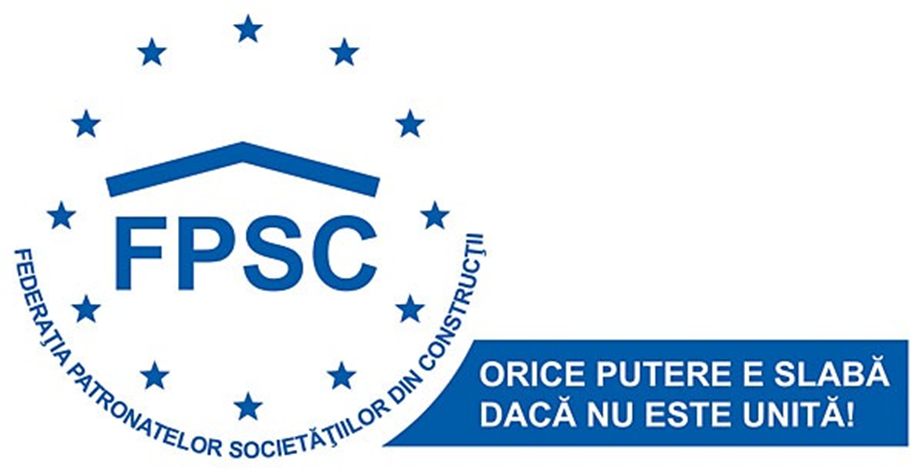 “Romania has a very serious problem in this area, of building materials. We import about 70% of the building materials, and for the building materials manufactured in Romania, the raw material is also imported. So if something happens in the European or world market in this area, from raw materials to building materials, we feel it right away,” said Adriana Iftime, vice president of FPSC at the conference hosted by Bucharest Real Estate Club.
“Romania has a very serious problem in this area, of building materials. We import about 70% of the building materials, and for the building materials manufactured in Romania, the raw material is also imported. So if something happens in the European or world market in this area, from raw materials to building materials, we feel it right away,” said Adriana Iftime, vice president of FPSC at the conference hosted by Bucharest Real Estate Club.
Double prices for building materials
As for last year’s increase in building materials, Iftime says the average was 40%, and in some cases even higher, such as steel, whose price was double. “We just noticed at the time. There have been big price increases from plastic products, pipes, polystyrene and other materials. I was even surprised at one point when powdered materials, such as mortars, screeds, adhesives, could not be sold because they had to be packed in bags. We got calls from the Federation and tried We need to analyze the phenomenon a bit. Romania doesn’t produce bags for packing powdery materials, paper bags. They import them from Bulgaria,” says Adriana Iftime.
Corrugated cardboard, napkins and toilet paper are produced locally. Iftime says it has spoken to manufacturers and it is difficult to start such a business because the markets are already busy, and even if it had been given money to develop packaging paper technology lines, manufacturers would have struggled to get one. find the market.
“And the surprise of this year is the increase in energy prices, which will obviously have a major impact on the building materials market, which is a very large energy consumer. Obviously, it will be more expensive to build. (..) An event such as the one currently taking place in Ukraine also makes us doubtful. Romania imports a lot of building materials from Ukraine,” adds Iftime.
The developer Akcent Development is going to supply building materials from abroad after he noticed that local producers no longer deliver with advance payment. In addition, the personnel from abroad will bring the material to the new project location. 300 Turkish workers will work on the project, which is due to be completed within two years. The developer has given up the facade of the blocks to fully ventilate and is moving to a mixed system, including ventilated facade and thermal system. Ceramic tiles, parquet and doors will also come from foreign suppliers.
Public health sector
A new wave of COVID-19 seems to have started in Europe. What the data shows
As the war in Ukraine has left us even more concerned, new news is beginning to emerge on the pandemic front. And they are not good at all. The week ended with a new peak of infections and hospitalizations in countries such as the United Kingdom, Ireland, the Netherlands, Switzerland and Italy.
On Saturday March 11, Dr. Eric Topol, founder and director of the Scripps Research Translational Institute, on Twitter: “The next wave has begun in Europe,” posting graphs of Covid-19 cases and hospitalizations using data from “Our World of Data.”
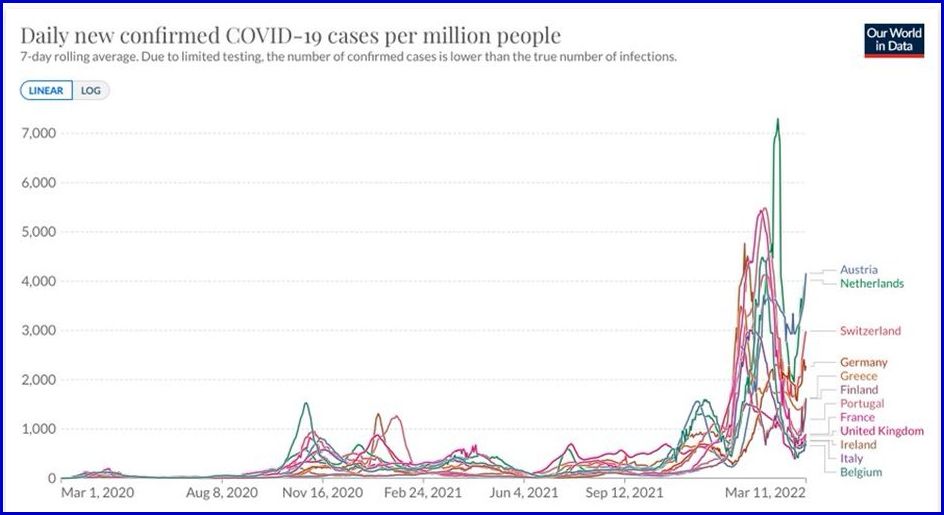
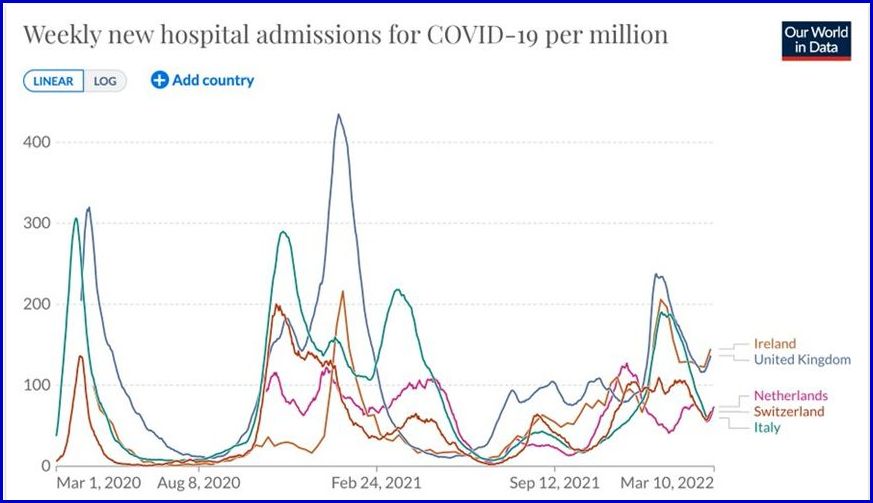
Registration on March 7, showing that the daily number of COVID-19 cases in Romania increases by 3,188 after more than 25,000 tests in the last 24 hours
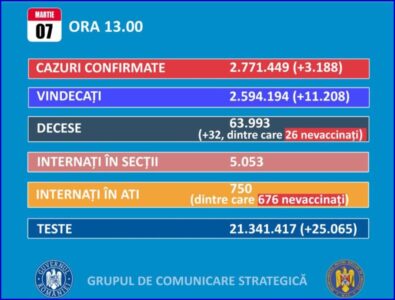 As many as 3,188 new cases of people infected with SARS-CoV-2 were registered in Romania in the past 24 hours, with 96 more than the day before, on more than 25,000 RT-PCR and rapid antigenic tests performed, the Strategic Communication Group (GCS) on Monday.
As many as 3,188 new cases of people infected with SARS-CoV-2 were registered in Romania in the past 24 hours, with 96 more than the day before, on more than 25,000 RT-PCR and rapid antigenic tests performed, the Strategic Communication Group (GCS) on Monday.
Of the new cases, 420 are in reinfected patients who tested positive more than 180 days after the initial infection.
Most new cases of infection compared to the previous report are in Bucharest – 1,148 and the districts (judet) Cluj – 203, Brasov – 194, Ilfov – 147 and Timis – 128.
Since the start of the pandemic, a total of 2,771,449 cases of infection with the new coronavirus have been recorded in Romania, of which 114,557 were in reinfected patients who tested positive more than 180 days after the first infection.
Disclaimer

The newsletter of the Dutch Romanian Network is compiled with great care. The Dutch Romanian Network cannot accept any liability for a possible inaccuracy and/or incompleteness of the information provided herein, nor can any rights be derived from the content of the newsletter. The articles do not necessarily reflect the opinion of the board.
